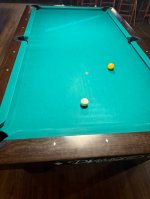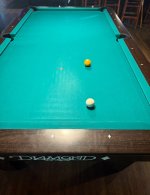You are using an out of date browser. It may not display this or other websites correctly.
You should upgrade or use an alternative browser.
You should upgrade or use an alternative browser.
Shot where the pocket is outside ur field of vision
- Thread starter Magictrat007
- Start date
typo I edited it almost immediately lol
A couple of techniques to better visualize shots like that:Any tips for shooting from one side of the table to the other where the pocket isn’t in your line of site or barely in the peripheral ? For example cutting both of the shots to the left. Corner not middle pockets.
Stand on the object ball to pocket line, and look carefully at the exact point in the pocket you want to send the object ball over. This is to see the exact line the OB has to take and remind yourself of where the pocket is.
Place the cue stick like a temporary rail just behind the object ball (and pointed to edge of the pocket. This should help you visualize the angle better. I think it's always easier to run a ball along the cushion because the rail tells you where the pocket is.
Also, thin cuts like that are candidates for the "double overlap" method of sighting: aim the inside edge of the CB at the point that's double the distance from the outside edge of the OB to the contact point.A couple of techniques to better visualize shots like that:
Stand on the object ball to pocket line, and look carefully at the exact point in the pocket you want to send the object ball over. This is to see the exact line the OB has to take and remind yourself of where the pocket is.
Place the cue stick like a temporary rail just behind the object ball (and pointed to edge of the pocket. This should help you visualize the angle better. I think it's always easier to run a ball along the cushion because the rail tells you where the pocket is.
pj
chgo
Last edited:
i have to try thatAlso, thin cuts like that are candidates for the "double overlap" method of sighting: aim the inside edge of the CB at a point that's double the distance from the outside edge of the OB to the contact point.
View attachment 810106
pj
chgo
thanks patrick...
i stand back and look at the line to the pocket from standing behind the cue ball
i can visualize the contact point and it helps me determine what type of angle it is to the pocket
i then use fractions or contact points to shoot it
trusting if i hit "there" it goes in the pocket ....
i can visualize the contact point and it helps me determine what type of angle it is to the pocket
i then use fractions or contact points to shoot it
trusting if i hit "there" it goes in the pocket ....
I like that I tried it already a few times and it gives me a good idea of where to hit the ball. It prevents me from over the cutting the ball and personally I would rather miss fat.A couple of techniques to better visualize shots like that:
Stand on the object ball to pocket line, and look carefully at the exact point in the pocket you want to send the object ball over. This is to see the exact line the OB has to take and remind yourself of where the pocket is.
Place the cue stick like a temporary rail just behind the object ball (and pointed to edge of the pocket. This should help you visualize the angle better. I think it's always easier to run a ball along the cushion because the rail tells you where the pocket is.
First pic top right and 2nd pic top leftI'm confused. Which corner are you trying to shoot both shots into --- The right corner or the left corner pocket from where you're standing behind the cue ball? You say to the left, but do you mean the left corner pocket for both shots?
OK, thanks. Usually, when a player refers to the pocket being out of their line of sight, they're referring to a back cut shot, where you are literally shooting the cue ball in the opposite direction of the pocket at an obtuse angle. For example: If you were to shoot the first shot in the left corner pocket (there could be a kiss there, so I wouldn't, but it's just to give you an idea). So in shooting the first shot into the right corner pocket, you can still see the line to the pocket when you're down on the shot.First pic top right and 2nd pic top left
The second shot looks like what we call a 50 yard line shot. Same thing either way -regardless of the distance, it's pretty much the same difficulty shooting it into either pocket and at that angle, you can still get a glimpse of the line to the pocket when you're down on the shot.
What jumps out at me......(I think often overlooked or practiced).....is......for both of these shots....speed is pretty much as important as aim.....You may think you have the perfect aim.....hit it too soft and the end result is an undercut.......hit it too hard and it tends to be an overcut.
Also.....the further the OB is from the pocket........a slight mis-hit error is magnified.....similar to golf.......a 250 yard drive slightly off line may still find the edge of the fairway........the same slightly off line drive that goes 300+ ends up off the fairway in the rough.
Also.....the further the OB is from the pocket........a slight mis-hit error is magnified.....similar to golf.......a 250 yard drive slightly off line may still find the edge of the fairway........the same slightly off line drive that goes 300+ ends up off the fairway in the rough.
franOK, thanks. Usually, when a player refers to the pocket being out of their line of sight, they're referring to a back cut shot, where you are literally shooting the cue ball in the opposite direction of the pocket at an obtuse angle. For example: If you were to shoot the first shot in the left corner pocket (there could be a kiss there, so I wouldn't, but it's just to give you an idea). So in shooting the first shot into the right corner pocket, you can still see the line to the pocket when you're down on the shot.
The second shot looks like what we call a 50 yard line shot. Same thing either way -regardless of the distance, it's pretty much the same difficulty shooting it into either pocket and at that angle, you can still get a glimpse of the line to the pocket when you're down on the shot.
is there a way you figure in this situation there could be a kiss or du you just visualize the path of the cue ball and object ball?
do you think the would occur close to the pocket or in the middle of the table or somewhere else?
A combination of both feel and some rules of thumb help players to determine if there is a potential kiss. With a cross bank for example, if both the cb and ob are lined up straight into the opposite pocket, the kiss is almost inevitable. There is a possibility to avoid it with extreme inside spin, which can help reverse the cb off the rail to cross the path of the ob after the ob already passed through. But it's only through practice and experience that you can learn the limitations of what adjustments you can and can't make.fran
is there a way you figure in this situation there could be a kiss or du you just visualize the path of the cue ball and object ball?
do you think the would occur close to the pocket or in the middle of the table or somewhere else?
thanks for the reply fran....A combination of both feel and some rules of thumb help players to determine if there is a potential kiss. With a cross bank for example, if both the cb and ob are lined up straight into the opposite pocket, the kiss is almost inevitable. There is a possibility to avoid it with extreme inside spin, which can help reverse the cb off the rail to cross the path of the ob after the ob already passed through. But it's only through practice and experience that you can learn the limitations of what adjustments you can and can't make.

